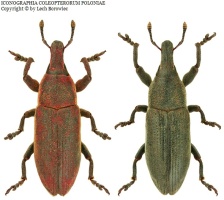Підтримуємо Вільну Україну
 We Support Free Ukraine
We Support Free Ukraine

Biodiversity Map
Taxa

Taxon count: 9
-
Lixus angustusSet as tree root ↑
Show taxon data → ⚑ [58] → Show taxon data
[58] → Show taxon data -
Curculio angustusSet as tree root ↑
Show taxon data → → Show taxon data -
Curculio bicolorSet as tree root ↑
Show taxon data → → Show taxon data -
Curculio sanguineusSet as tree root ↑
Show taxon data → → Show taxon data -
Lixus rufulusSet as tree root ↑
Show taxon data → → Show taxon data -
Ortholixus bicolorSet as tree root ↑
Show taxon data → → Show taxon data -
Ortholixus circumdatusSet as tree root ↑
Show taxon data → → Show taxon data -
Ortholixus sanguineusSet as tree root ↑
Show taxon data → → Show taxon data -
Ortholixus seniculusSet as tree root ↑
Show taxon data → → Show taxon data
-
Arthropodaphylum
Click to switch
to select orders
and filters > -
Hexapodasubphylum
Click to switch
to select orders
and filters > -
Insectaclass
Click to switch
to select orders
and filters > -
Coleopteraorder
Click to set
as the main taxon
and as a base
← of the left panel > -
Polyphagasuborder
Click to set
as the main taxon
and as a base
← of the left panel > -
Cucujiformiaseries
Click to set
as the main taxon
and as a base
← of the left panel > -
Curculionoideasuperfamily
Click to set
as the main taxon
and as a base
← of the left panel > -
Curculionidaefamily
Click to set
as the main taxon
and as a base
← of the left panel > -
Lixinaesubfamily
Click to set
as the main taxon
and as a base
← of the left panel > -
Lixinitribe
Click to set
as the main taxon
and as a base
← of the left panel > -
Lixusgenus
Click to set
as the main taxon
and as a base
← of the left panel > -
Ortholixussubgenus
Click to set
as the main taxon
and as a base
← of the left panel >
species:
Lixus (Ortholixus) angustus
PL
YES
name status: valid name
BioMap ID: 1046905
taxon code: 5162
taxonomy checked: YES
Polish Red List: VU
Data on distribution in Poland

Statistics
- Records: 58
- Publications: 39
- Collections: 2
- Publication authors: 31
- Illustrations (iconography): 1
- Photos (specimen/observation): lacking
Taxon description
Gatunek zamieszkujący południową, środkową i południowo-wschodnią część Europy, na wschód sięgający po Kaukaz, Azję Mniejszą i Azję Zachodnią. W Polsce notowany z nielicznych stanowisk w sześciu tylko krainach na podstawie materiałów zbieranych w ubiegłym stuleciu i na początku bieżącego wieku. Wzmianka o występowaniu tego gatunku w Ełku na Pojezierzu Mazurskim polegała niewątpliwie na pomyłce. Występuje na suchych łąkach, polach, pastwiskach, zboczach, miejscach ruderalnych i przydrożach. Pojaw postaci dojrzałych przypada na maj-czerwiec. Spotykano je na komosie białej — Chenopodium album L., komosie wielonasiennej — Ch. polyspermum L., buraku zwyczajnym — Beta vulgaris L., iglicy pospolitej — Erodium cicutarium (L.) L’Hérit goryczelach — Picris L., mniszkach — Taraxacum Zinn., jastrzębcach — Hieracium L. i brodawnikach — Leontodon L. Larwa żeruje w rdzeniu dolnej części łodygi lub w korzeniu brodawnika jesiennego — L. autumnalis L.; przed przepoczwarczeniem wywierca otwór wyjściowy, który zakrywa brunatnymi ekskrementami. W końcu lipca ukazują się pierwsze młode imagines.
Illustrations
... browse
 Lixus
Lixusangustus
External data sources
- Ostatnie rekordy
-
799494
 ×
× Curculionidae: Lixus angustus, PL (Gosik 2006d)
Curculionidae: Lixus angustus, PL (Gosik 2006d) -
799493
 ×
× Curculionidae: Lixus angustus, PL (Grzywocz 2001(1999-2000))
Curculionidae: Lixus angustus, PL (Grzywocz 2001(1999-2000)) -
799492
 ×
× Curculionidae: Lixus angustus, PL (Łętowski et Ptaszyńska 2006)
Curculionidae: Lixus angustus, PL (Łętowski et Ptaszyńska 2006) -
799491
 ×
× Curculionidae: Lixus angustus, PL (Łętowski et Gosik 2002)
Curculionidae: Lixus angustus, PL (Łętowski et Gosik 2002) -
799490
 ×
× Curculionidae: Lixus angustus, PL (Mazur 1994d)
Curculionidae: Lixus angustus, PL (Mazur 1994d) -
799489
 ×
× Curculionidae: Lixus angustus, PL (Stachowiak 1999(1998))
Curculionidae: Lixus angustus, PL (Stachowiak 1999(1998)) -
799488
 ×
× Curculionidae: Lixus angustus, PL (Łętowski et al. 2001a)
Curculionidae: Lixus angustus, PL (Łętowski et al. 2001a) -
741932
 ×
× Curculionidae: Lixus angustus, PL (Wanat 2009)
Curculionidae: Lixus angustus, PL (Wanat 2009) -
740985
 ×
× Curculionidae: Lixus angustus, PL (Stachowiak 1999(1998))
Curculionidae: Lixus angustus, PL (Stachowiak 1999(1998)) -
579280
 ⊡
⊡ Curculionidae: Lixus angustus, PL, Podlasie, lubelskie, Sobibór ad Włodawa, UTM FC80, 2004, leg. M. Wanat
Curculionidae: Lixus angustus, PL, Podlasie, lubelskie, Sobibór ad Włodawa, UTM FC80, 2004, leg. M. Wanat - ... more
- Powiązane publikacje
-
Wanat M. 2009. Nowe dane o rozmieszczeniu kilkunastu rzadkich gatunków ryjkowców (Coleoptera: Curculionoidea) w Polsce. Wiad. Entomol., 28(2):132-134 [498].
 full text
full text Show records
Show records -
Łętowski J., Ptaszyńska A. 2006. Ryjkowcowate (Coleoptera: Curculionoidea) rezerwatu „Żmudź" (Kotlina Dubienki). [In:] Ochrona owadów w Polsce. Badania entomologiczne a obecna sytuacja prawna i organizacyjna ochrony przyrody. Wiad. Entomol., 25(Supl. 2):147-154.
 full text
full text Show records
Show records -
Gosik R. 2006d. Weevils (Curculionoidea) of the middle part of the Bug River Valley. Ann. UMCS, C, 61:7-69.
 Show records
Show records -
Łętowski J., Gosik R. 2002. Ryjkowcowate (Coleoptera, Curculionidea: Rhinomaceridae, Attelabidae, Apionidae, Curculionidae) projektowanego rezerwatu "Machnowska Góra". Parki Nar. Rez. Przyr., 21(4):471-484.
 Show records
Show records -
Grzywocz J. 2001(1999-2000). Doniesienia o chrząszczach znad Dolnej Nidy. Acta Ent. Siles., 7-8():71-73.
 Show records
Show records - ... more
- Powiązane zbiory
-
ISEZ PAN
 Show records
Show records -
Wanat M.
 Show records
Show records



